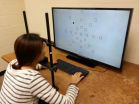(Press-News.org) A new study from North Carolina State University and the University of Toronto finds that people pay more attention to the upper half of their field of vision – a finding which could have ramifications for traffic signs to software interface design.
"Specifically, we tested people's ability to quickly identify a target amidst visual clutter," says Dr. Jing Feng, an assistant professor of psychology at NC State and lead author of a paper on the work. "Basically, we wanted to see where people concentrate their attention at first glance."
Researchers had participants fix their eyes on the center of a computer screen, and then flashed a target and distracting symbols onto the screen for 10 to 80 milliseconds. The screen was then replaced by an unconnected "mask" image to disrupt their train of thought. Participants were asked to indicate where the target had been located on the screen.
Researchers found that people were 7 percent better at finding the target when it was located in the upper half of the screen.
"It doesn't mean people don't pay attention to the lower field of vision, but they were demonstrably better at paying attention to the upper field," Feng says.
"A difference of 7 percent could make a significant difference for technologies that are safety-related or that we interact with on a regular basis," Feng says. "For example, this could make a difference in determining where to locate traffic signs to make them more noticeable to drivers, or where to place important information on a website to highlight that information for users."
INFORMATION:
The paper, "Upper Visual Field Advantage in Localizing a Target among Distractors," is published online in the open-access journal i-Perception. The paper was co-authored by Dr. Ian Spence of the University of Toronto. The work was supported, in part, by the Natural Sciences and Engineering Research Council of Canada.
Study: People pay more attention to the upper half of field of vision
2014-04-22
ELSE PRESS RELEASES FROM THIS DATE:
Inserm and the Institut Pasteur identify a new variant of Ebola virus in Guinea
2014-04-22
This news release is available in French.
Performed in less than a month, sequencing of the complete genome and subsequent phylogenetic analysis show that the virus present in Guinea forms a clade (variant) that is distinct from strains previously identified in the Democratic Republic of Congo and in Gabon. Epidemiological investigations also linked the laboratory confirmed cases with the initial deaths recorded during the December 2013 outbreak.
Ebola virus is a lethal, highly contagious virus for which there is presently no treatment. The symptoms are somewhat ...
How the body fights against viruses
2014-04-22
This news release is available in German. Scientists of the Max F. Perutz Laboratories of the University of Vienna and the Medical University of Vienna, together with colleagues of the ETH Zurich, have now shown how double stranded RNA, such as viral genetic information, is prevented from entering the nucleus of a cell. During the immune response against viral infection, the protein ADAR1 moves from the cell nucleus into the surrounding cytoplasm. There it modifies viral RNA to inhibit reproduction of the virus. But how is the human genome protected from inadvertent ...
What gave us the advantage over extinct types of humans?
2014-04-22
Jerusalem, April 22, 2014 -- In parallel with modern man (Homo sapiens), there were other, extinct types of humans with whom we lived side by side, such as Neanderthals and the recently discovered Denisovans of Siberia. Yet only Homo sapiens survived. What was it in our genetic makeup that gave us the advantage?
The truth is that little is known about our unique genetic makeup as distinguished from our archaic cousins, and how it contributed to the fact that we are the only species among them
to survive. Even less is known about our unique epigenetic makeup, but it ...
Turoctocog alfa in patients with hemophilia A: Added benefit not proven
2014-04-22
Turoctocog alfa (trade name: NovoEight) has been approved since November 2013 for the prevention and treatment of bleeding in patients with haemophilia A. In an early benefit assessment pursuant to the "Act on the Reform of the Market for Medicinal Products" (AMNOG), the German Institute for Quality and Efficiency in Health Care (IQWiG) examined whether this new active ingredient offers an added benefit over the appropriate comparator therapy.
According to the findings, an added benefit of turoctocog alfa is not proven. As no relevant study is available for comparison ...
Life stressors trigger neurological disorders, researchers find
2014-04-22
Washington, DC -- When mothers are exposed to trauma, illness, alcohol or other drug abuse, these stressors may activate a single molecular trigger in brain cells that can go awry and activate conditions such as schizophrenia, post-traumatic stress disorder and some forms of autism.
Until now, it has been unclear how much these stressors have impacted the cells of a developing brain. Past studies have shown that when an expectant mother exposes herself to alcohol or drug abuse or she experiences some trauma or illness, her baby may later develop a psychiatric disorder, ...
Ask yourself: Will you help the environment?
2014-04-22
This news release is available in French. Whether it's recycling, composting or buying environmentally friendly products, guilt can be a strong motivator — not just on Earth Day.
Now, research from Concordia University's John Molson School of Business published in the Journal of Business Ethics, proves that even just asking ourselves, or predicting, whether we will engage in sustainable shopping behaviour can increase the likelihood of following through — especially when there's an audience.
Lead author, marketing professor Onur Bodur explains that, "this is because ...
Brain size matters when it comes to animal self-control
2014-04-22
Chimpanzees may throw tantrums like toddlers, but their total brain size suggests they have more self-control than, say, a gerbil or fox squirrel, according to a new study of 36 species of mammals and birds ranging from orangutans to zebra finches.
Scientists at Duke University, UC Berkeley, Stanford, Yale and more than two-dozen other research institutions collaborated on this first large-scale investigation into the evolution of self-control, defined in the study as the ability to inhibit powerful but ultimately counter-productive behavior. They found that the species ...
Male health linked to testosterone exposure in womb, study finds
2014-04-22
Men's susceptibility to serious health conditions may be influenced by low exposure to testosterone in the womb, new research suggests.
A study has revealed how men's testosterone levels may be determined before they are born.
Understanding why some men have less of the hormone than others is important because testosterone is crucial for life-long health. Low levels of the hormone have been linked to obesity, diabetes and heart disease.
Researchers have shown that the cells responsible for producing testosterone in adults – known as Leydig cells – are derived from ...
FASEB releases updated NIH state factsheets
2014-04-22
The Federation of American Societies for Experimental Biology (FASEB) has released updated factsheets for fiscal year (FY) 2013 highlighting how funding from the National Institutes of Health (NIH) benefits each of the 50 states, DC, and Puerto Rico. "FASEB is pleased to make these factsheets available to help citizens and policymakers understand the significance of NIH to their state," said FASEB President, Margaret K. Offermann, MD, PhD. NIH is the nation's leading source for biomedical research funding, investing $29.2 billion in FY 2013 in medical research, 80 percent ...
Report recommends insurers use prescription monitoring data to reduce opioid abuse, deaths
2014-04-22
WALTHAM, Mass. – The Prescription Drug Monitoring Program Center of Excellence at Brandeis University has issued a ground-breaking report recommending that medical insurers use prescription monitoring data to reduce the overdoses, deaths and health care costs associated with abuse of opioids and other prescription drugs.
"At a time when the misuse and abuse of prescription opioids has reached epidemic levels, it's important that third party payers be able to use states' prescription monitoring data to make sure these drugs are prescribed appropriately," said Peter Kreiner, ...




